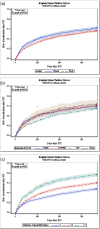Impact of diabetes on long-term all-cause re-hospitalization after revascularization with percutaneous coronary intervention
- PMID: 35861372
- PMCID: PMC9310244
- DOI: 10.1177/14791641221113788
Impact of diabetes on long-term all-cause re-hospitalization after revascularization with percutaneous coronary intervention
Abstract
Purpose: The purpose of the study was to investigate the incidence, cause and probability of re-hospitalization within 30 and 365 days after percutaneous coronary intervention (PCI) in patients with diabetes.
Method: Between January 2010 and September 2014, 2763 patients with diabetes were treated with PCI at two Hospitals in Western Denmark. Reasons for readmission within 30 and 365 days were identified.
Results: Readmission risks for patients with diabetes were 58% within 365 days and 18% within 30 days. Reason for readmission was ischemic heart disease (IHD) in 725 patients (27%), and non-IHD-related reasons in 826 patients (31%). IHD-related readmission within 365 days was associated with female gender (OR 1.3, 95% CI: 1.1-1.5), and non-ST-segment elevation myocardial infarction, compared to stable angina at the index hospitalization (OR 1.3, 95% CI: 1.1-1.6). Among patients with diabetes, increased risk of readmission due to other reasons were age (OR 1.3, 95% CI: 1.2-1.5) and higher scores of modified Charlson Comorbidity index (CCI): CCI ≥3 (OR 3.6, 95% CI: 2.8-4.6).
Conclusion: More than half of the patients with diabetes mellitus undergoing PCI were readmitted within 1 year. Comorbidities were the strongest predictor for non-IHD-related readmission, but did not increase the risk for IHD-related readmissions.
Keywords: Coronary artery disease; diabetes mellitus; percutaneous coronary intervention; re-hospitalization.
Conflict of interest statement
Figures
Similar articles
-
Revascularization Trends in Patients With Diabetes Mellitus and Multivessel Coronary Artery Disease Presenting With Non-ST Elevation Myocardial Infarction: Insights From the National Cardiovascular Data Registry Acute Coronary Treatment and Intervention Outcomes Network Registry-Get with the Guidelines (NCDR ACTION Registry-GWTG).Circ Cardiovasc Qual Outcomes. 2016 May;9(3):197-205. doi: 10.1161/CIRCOUTCOMES.115.002084. Epub 2016 May 10. Circ Cardiovasc Qual Outcomes. 2016. PMID: 27166210
-
Predictors and etiologies of 30-day readmissions in patients with non-ST-elevation acute coronary syndrome.Catheter Cardiovasc Interv. 2019 Feb 15;93(3):373-379. doi: 10.1002/ccd.27838. Epub 2018 Oct 2. Catheter Cardiovasc Interv. 2019. PMID: 30280472
-
All-cause readmission and repeat revascularization after percutaneous coronary intervention.Cardiol J. 2012;19(2):174-9. doi: 10.5603/cj.2012.0030. Cardiol J. 2012. PMID: 22461051
-
Incidence and correlates of major bleeding after percutaneous coronary intervention across different clinical presentations.Am Heart J. 2014 Sep;168(3):248-55. doi: 10.1016/j.ahj.2014.05.018. Epub 2014 Jun 11. Am Heart J. 2014. PMID: 25173534 Review.
-
Review of early hospitalisation after percutaneous coronary intervention.Int J Cardiol. 2017 Jan 15;227:370-377. doi: 10.1016/j.ijcard.2016.11.050. Epub 2016 Nov 9. Int J Cardiol. 2017. PMID: 27839805 Review.
Cited by
-
The association between metabolic syndrome and major adverse cardiac and cerebrovascular events in patients with acute coronary syndrome undergoing percutaneous coronary intervention.Sci Rep. 2024 Jan 6;14(1):697. doi: 10.1038/s41598-024-51157-w. Sci Rep. 2024. PMID: 38184738 Free PMC article.
-
Prognostic nutritional index in the prediction of adverse cardiac and cerebrovascular events in ST-segment elevation myocardial infarction patients with type 2 diabetes mellitus in Urumqi, China: a retrospective cohort study.BMJ Open. 2025 Jun 24;15(6):e099750. doi: 10.1136/bmjopen-2025-099750. BMJ Open. 2025. PMID: 40555440 Free PMC article.
References
-
- Montalescot G, Sechtem U, Achenbach S, et al. ESC guidelines on the management of stable coronary artery disease: the task force on the management of stable coronary artery disease of the European Society of Cardiology. Eur Heart J 2013; 34: 2949–3003. - PubMed
-
- Maeng M, Jensen LO, Kaltoft A, et al. Comparison of stent thrombosis, myocardial infarction, and mortality following drug-eluting versus bare-metal stent coronary intervention in patients with diabetes mellitus. Am J Cardiol 2008; 102: 165–172. - PubMed
MeSH terms
LinkOut - more resources
Full Text Sources
Medical
Miscellaneous


